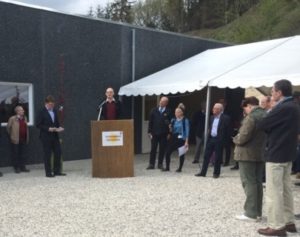Denmark: Construction Start on Dronninglund’s Solar District Heating Plant
April 10, 2013
On 15 March, the excavators began their work for Denmark’s largest solar district heating project so far. The collector field in the town of Dronninglund, about 30 km northeast of Aalborg, will have an area of 35,000 m², but installing the collectors will only be the last step. First, there is the seasonal pit heat storage – a hole in the ground filled with 60,000 m³ of water. In combination with the seasonal heat storage, the solar plant is said to achieve a yield of 15,000 MWh per year and to provide 40 % of the heat for the local district heating network with its 1,350 customers. In the long run, the collectively owned district heating company Dronninglund Fjernvarme plans to provide all of its heat through renewable energies to keep heat prices stable, albeit there have not yet been any details on how to accomplish this task. Currently, the heating network’s supply is based on four combined gas-based heating plants (7 MWel and 12 MWth total) and two biofuel boilers (15.1 MW total).
The network pipes will require an average temperature of 75 °C per year. With enough sunlight, the solar plant will reach the temperature needed to feed heat directly to the network. In winter, when the temperature cannot be reached, the solar plant will feed low-temperature heat to the seasonal storage. The storage will be combined with an absorption chiller (2 MW of cooling capacity), which will work as a heat pump to allow the network to use the low-temperature heat. Therefore, the network’s temperature can get as low as 15 °C, making even solar heat at 30 to 40 °C a valuable resource in wintertime, usually between November and February. “We will set up an absorption chiller fuelled with bio-oil instead of an electrical heat pump. The Danish tax system has made this the more attractive option,” says Per Alex Sørensen of Danish engineering company PlanEnergi, the company which has developed and planned the project from the beginning. In summer, the storage can be heated up to 90 °C, so that the solar collectors will be able to absorb heat of up to 95 °C on a sunny day.
The storage design is very simple. It is basically a hole in the ground. A plastic foil avoids that the water drains away. The storage is insulated only on the cover, reducing costs to a mere 35 EUR/m³, including in- and outlet pipes.
Construction of the solar field is scheduled for the last quarter of this year. The provider and installer of the 2,800 collectors is Danish company ARCON Solar, a subsidiary of Danish group SolarCAP and specialised in large-scale turnkey solar thermal solutions. As in other large-scale installations, the collectors will have an absorber area of 12.5 m². The entire collector will have one large harp type absorber consisting of 18 fins, laser-welded to the absorber tubes. An insulating transparent foil will reduce convection losses and, according to ARCON, will result in the highest performing flat plate collector on the market. “The ARCON HT panel has roots dating back to the beginning of the 1980s, when the first version was developed in Sweden. The design has since been optimised for large-scale solar plants. Today, ARCON produces 15 different types of HT Panels in its factory in Skørping, Denmark,” says Søren Elisiussen, General Manager of ARCON.
According to PlanEnergi, the cost for the solar collectors – including internal piping and the foundation – will be approximately 155 EUR/m². The total investment for the project will be EUR 14.5 million, leading to a heat production price of around 58 EUR/MWh. The EUR 2.1 million subsidy by the Danish national Energy Technology Development and Demonstration Programme, EUDP, will reduce the effective heat price to about 50 EUR/MWh.
The solar collector area providing heat for district heating networks in Denmark currently amounts to a countrywide 280,000 m². The aim over the next years will be to add another 416,000 m², of which more than 300,000 m² are planned to be installed in 2013, according to the statistics of the Danish district heating association.
More information:
http://www.dronninglundfjernvarme.dk
http://www.arcon.dk
http://www.planenergi.dk
http://www.fjernvarmen.dk


